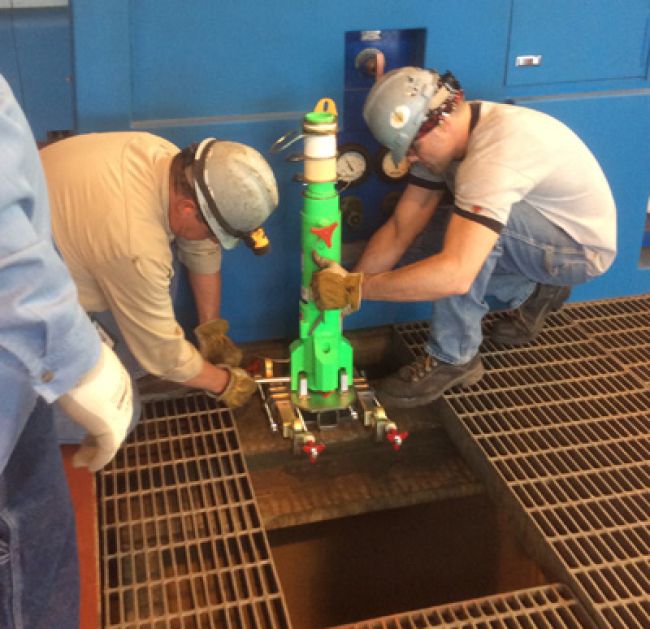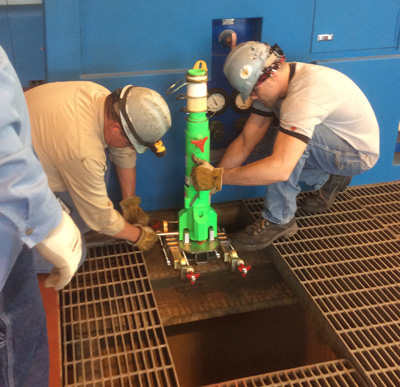
Scenario-Based Fall Protection Solutions

At least once in their career, nearly every safety worker in the utility business has been – or will be – faced with the need to use fall protection in an area where there is no place to tie off. In my role as a safety technician, I work with personnel in both generation and transmission business units; fall protection is needed in this line of work, but I have found that anchorage points can sometimes be few and far between. It’s a problem that clearly needs to be solved, and in this article I will share what my company has done to provide scenario-based solutions.
Scenario One
During an outage preparation meeting a couple of years ago, I was presented with some fall protection issues that employees had been dealing with. These issues specifically related to anchorage points for crews working on our main steam stop valves. Once the grating and I-beams were removed from the valve pit area, all potential anchorage points were eliminated, and thus no fall protection could be properly anchored and used in the valve pit area. Given this problem, I contacted a fall protection solutions group that came to visit our facility and gathered information regarding our anchorage concerns. While the solutions group was on-site, we also discussed possible recommendations to solve the anchorage problem. In a follow-up email after our initial meeting, the solutions group provided detailed information about the different types of equipment we could use to eliminate our anchorage issues on this particular project. The detailed equipment recommendations were then presented to our company’s personnel, and ultimately the decision was made to purchase the recommended equipment.
That recommended equipment was two advanced portable fall arrest posts, which allow us to provide overhead tie-off and utilize small self-retracting lifelines, or SRLs, so that workers in the valve pit are equipped with complete fall protection. Among the advantages of the portable fall arrest posts is how the posts are mounted. They offer several mounting applications that range from weld-on plates to beam clamps that are designed to fit 6-inch to 14-inch I-beams, meaning that we can use the posts in numerous locations throughout the company. Time and time again, the equipment has proven to be the solution to many of our fall protection needs in both generation and transmission work, including in Scenario Two below.
Scenario Two
Approximately one year after Scenario One was addressed, I was working on the transmission side of the company when I received a call about several upset employees who were at a substation. They were working on top of a large power transformer and were frustrated with fall protection issues. Their biggest frustration was that although the technicians knew they needed to be tied off, the only real place for them to tie off was at their feet. But being tied off at their feet while using 6-foot lanyards that hung down created a tripping hazard that was greater than the potential hazard of falling off the transformer.
The group also identified several other safety issues they had concerning their work on top of the transformer. In addition to only being able to tie off at their feet, these issues included not being able to reach the equipment they needed to work on once they were tied off, and the potential for leading edge failure if an employee was able to find a lanyard long enough to be able to move around on top of the transformer.
To address these hazards, we gathered together, discussed what needed to be done and agreed to identify a solution that would provide the required fall protection for the crew. After contacting the fall protection solutions group – the same group who helped us in Scenario One – they offered to come back to our location to study the situation and formulate new recommended solutions. We knew we needed to obtain something that was portable due to where it was going to be set up. The solutions group went to work and came up with a couple of ideas, and they provided us with some equipment to try that wasn’t yet on the market.
After a couple months of trying out the equipment on various transformers, we still were unable to come up with a workable solution to the hazards we were dealing with. Given our lack of success with the new options, we turned our attention back to the advanced portable fall arrest posts used in Scenario One to see if and how we could make them work. There were several issues that quickly came to light. The first concern was that the base plates would have to be welded on and the transformer was filled with oil. The second concern was being able to make sure the transformer was grounded properly while the welding process was taking place. Several meetings occurred before we welded our first plate onto a transformer. The weld-on brackets were accompanied by detailed written instructions from the manufacturer about the welding process. It was a cold-weld process that included 14 2-inch welds alternating around the entire base plate until all sides were welded solid. When the base plate was completed, the post was installed by simply pulling the attachment pin and positioning the post over the base plate, aligning the holes in both the plate and post, and reinstalling the attachment pin. The advanced portable fall arrest post then was easily able to be leveled by utilizing thumb-screw levelers. Once the post was level, there was a tie-off on top of the transformer for three individuals, enabling them to safely maneuver without tripping over any lanyards.
We have now installed base plates at both ends of some of our larger transformers. By placing the portable fall arrest posts in position and installing an EZ line between posts, a horizontal lifeline is created for two people who can travel from one end of the transformer to the other without worrying about tripping over lanyards.
Another option is to go with a longer SRL. Our employees like to use an 11-foot SRL because it gives them a little extra room to move around on top of the transformer.
A Great Safety Success
The scenario-based solutions presented in this article have been a great success for our company, providing fall protection in places where we have struggled to do so in the past.
With regard to transformer fall protection, to date, we have not finished installing base plates on all of our transformers, but we do have an ongoing installation process. When a transformer comes out of service for maintenance, one of the first things we do is schedule a base plate to be welded onto it. The welding process for the base plates requires that a certified welder do the work. Because of this requirement, our company’s transmission group sent several of their craft people to welding school to earn their certification so that we will always have a qualified welder available to install base plates.
Finally, I am not sure what other companies are using for fall protection on transformers, but what I do know is that the advanced portable fall arrest posts, weld-on plates and EZ lines have provided a very simple yet adequate setup to address the challenge of keeping our employees safe when they work on top of our large power transformers.
About the Author: Rob D. Adams, CLCP, CUSP, is a safety technician for Sunflower Electric Power Corp., headquartered in Hays, Kansas. He can be reached at radams@sunflower.net.

